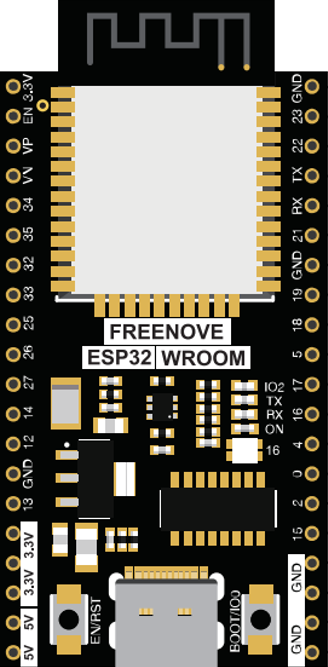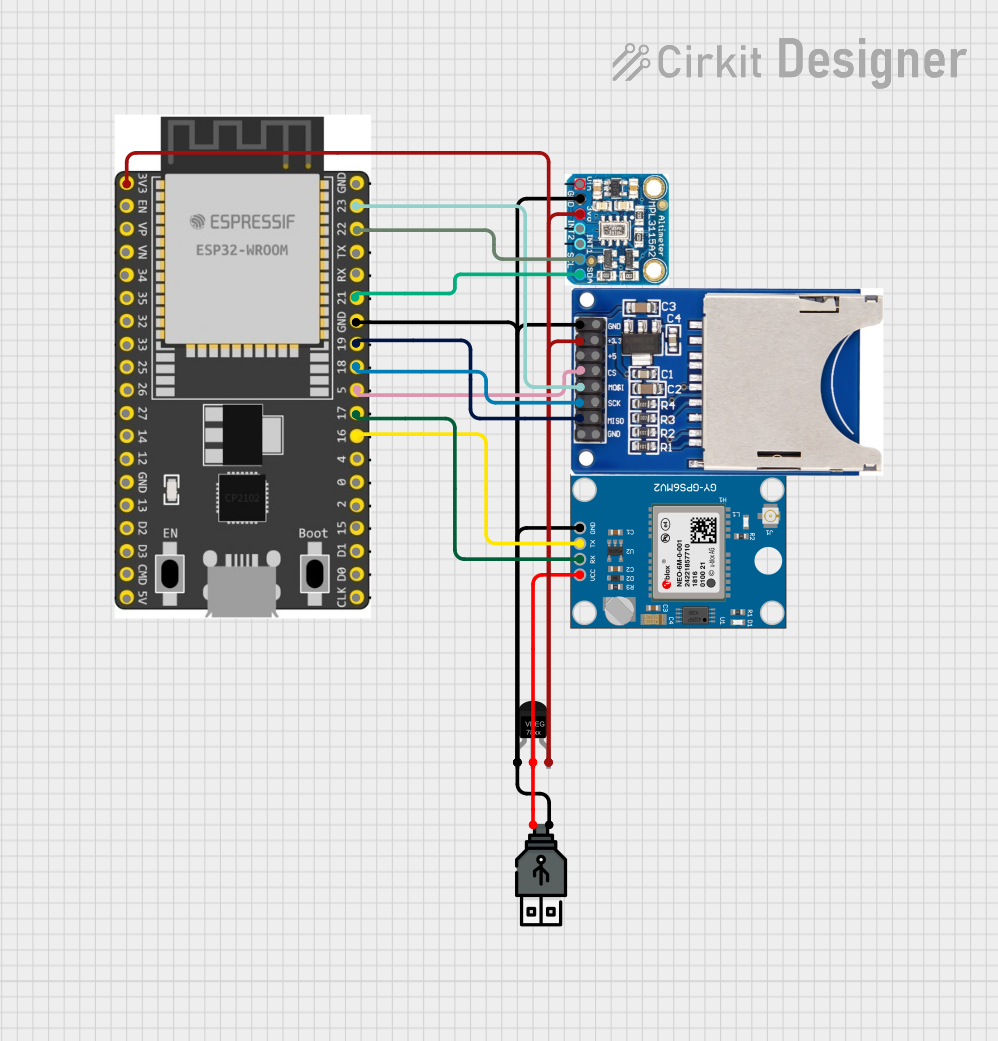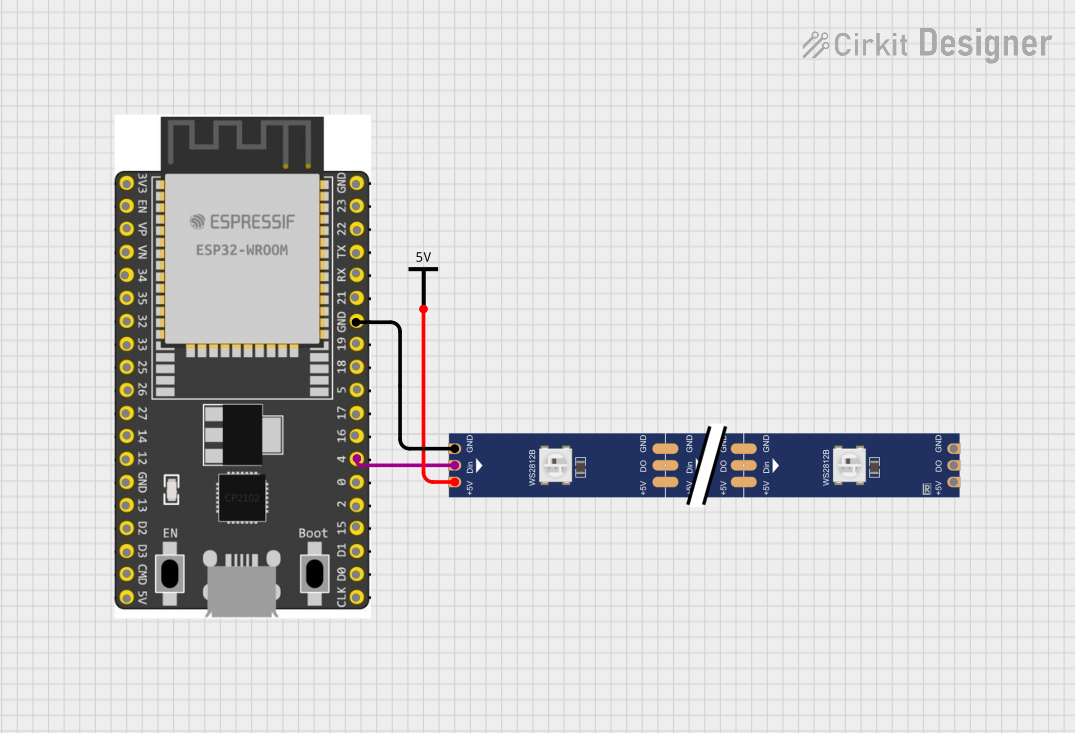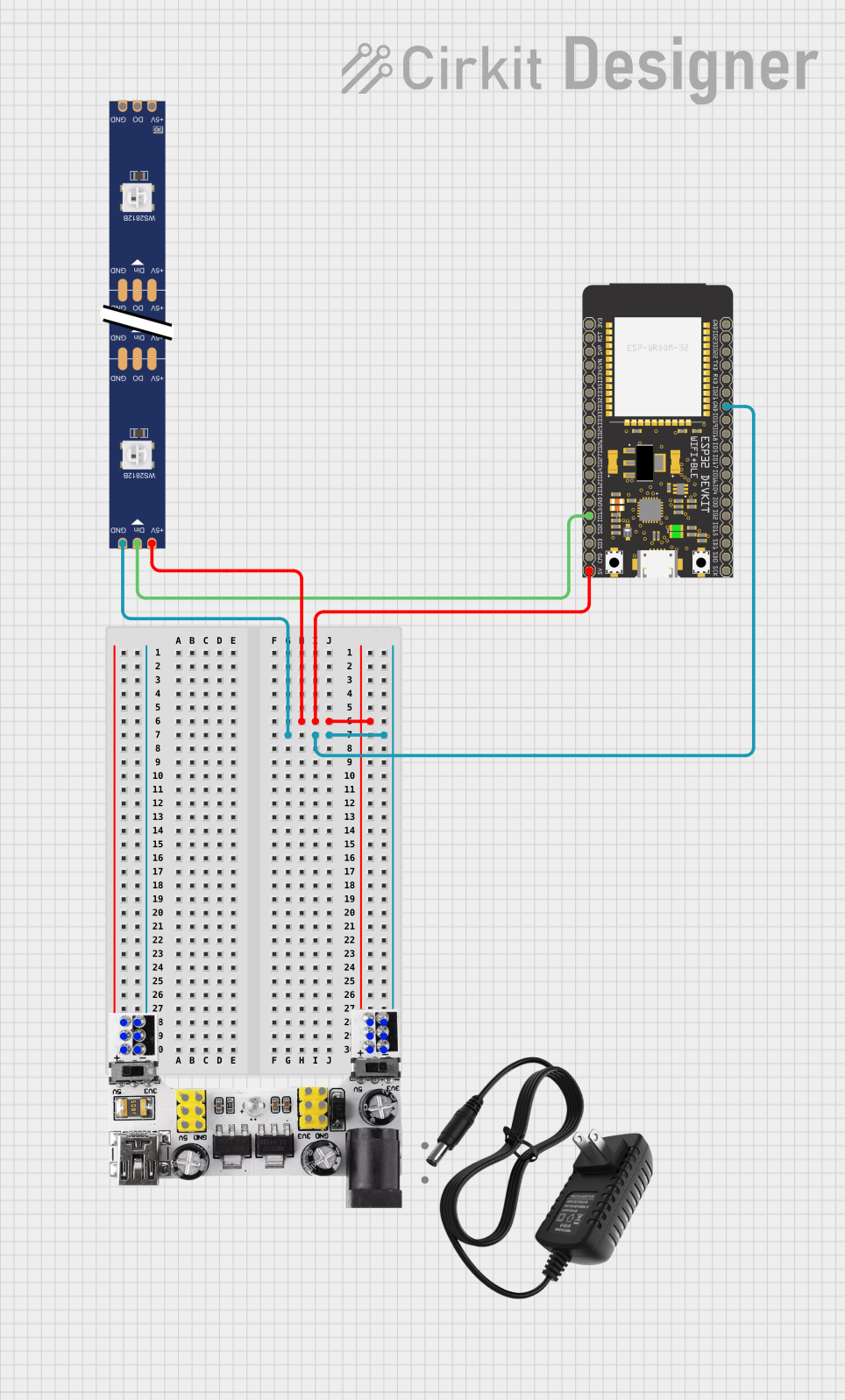
How to Use ESP32-WROOM: Examples, Pinouts, and Specs

 Design with ESP32-WROOM in Cirkit Designer
Design with ESP32-WROOM in Cirkit DesignerIntroduction
The ESP32-WROOM, manufactured by Freenove, is a powerful Wi-Fi and Bluetooth microcontroller module designed for a wide range of applications. It features dual-core processing, making it ideal for Internet of Things (IoT) projects, real-time data processing, and other complex tasks. With its robust wireless connectivity and versatile GPIO pins, the ESP32-WROOM is a popular choice for developers and hobbyists alike.
Explore Projects Built with ESP32-WROOM

 Open Project in Cirkit Designer
Open Project in Cirkit Designer
 Open Project in Cirkit Designer
Open Project in Cirkit Designer
 Open Project in Cirkit Designer
Open Project in Cirkit Designer
 Open Project in Cirkit Designer
Open Project in Cirkit DesignerExplore Projects Built with ESP32-WROOM

 Open Project in Cirkit Designer
Open Project in Cirkit Designer
 Open Project in Cirkit Designer
Open Project in Cirkit Designer
 Open Project in Cirkit Designer
Open Project in Cirkit Designer
 Open Project in Cirkit Designer
Open Project in Cirkit DesignerCommon Applications and Use Cases
- IoT devices and smart home automation
- Wireless sensor networks
- Real-time data monitoring and logging
- Robotics and automation systems
- Wearable devices
- Bluetooth Low Energy (BLE) applications
Technical Specifications
The ESP32-WROOM module is packed with features that make it a versatile and powerful microcontroller. Below are its key technical specifications:
| Specification | Details |
|---|---|
| Microcontroller | Tensilica Xtensa® 32-bit LX6 dual-core processor |
| Clock Speed | Up to 240 MHz |
| Flash Memory | 4 MB (varies by model) |
| SRAM | 520 KB |
| Wireless Connectivity | Wi-Fi 802.11 b/g/n, Bluetooth v4.2 + BLE |
| Operating Voltage | 3.3V |
| Input Voltage Range | 3.0V to 3.6V |
| GPIO Pins | 34 (multipurpose, including ADC, DAC, PWM, I2C, SPI, UART, etc.) |
| ADC Channels | 18 (12-bit resolution) |
| DAC Channels | 2 (8-bit resolution) |
| Power Consumption | Ultra-low power consumption in deep sleep mode (as low as 10 µA) |
| Operating Temperature | -40°C to 85°C |
| Dimensions | 18 mm x 25.5 mm |
Pin Configuration and Descriptions
The ESP32-WROOM module has a total of 38 pins. Below is a table describing the key pins and their functions:
| Pin Name | Type | Description |
|---|---|---|
| GND | Power | Ground pin |
| 3V3 | Power | 3.3V power supply output |
| EN | Input | Enable pin (active high) |
| IO0 | GPIO/Boot Mode | GPIO pin 0, also used to enter bootloader mode during programming |
| IO2 | GPIO | General-purpose input/output pin |
| IO4 | GPIO | General-purpose input/output pin |
| IO12 | GPIO/ADC | GPIO pin 12, can also function as an ADC input |
| IO13 | GPIO/ADC | GPIO pin 13, can also function as an ADC input |
| IO14 | GPIO/PWM | GPIO pin 14, supports PWM functionality |
| IO15 | GPIO/PWM | GPIO pin 15, supports PWM functionality |
| IO16 | GPIO | General-purpose input/output pin |
| IO17 | GPIO | General-purpose input/output pin |
| IO18 | GPIO/SPI | GPIO pin 18, can function as SPI clock (SCK) |
| IO19 | GPIO/SPI | GPIO pin 19, can function as SPI data input (MISO) |
| IO21 | GPIO/I2C | GPIO pin 21, can function as I2C data (SDA) |
| IO22 | GPIO/I2C | GPIO pin 22, can function as I2C clock (SCL) |
| IO23 | GPIO/SPI | GPIO pin 23, can function as SPI data output (MOSI) |
| IO25 | GPIO/DAC | GPIO pin 25, can function as a DAC output |
| IO26 | GPIO/DAC | GPIO pin 26, can function as a DAC output |
| IO27 | GPIO/ADC | GPIO pin 27, can also function as an ADC input |
| IO32 | GPIO/ADC | GPIO pin 32, can also function as an ADC input |
| IO33 | GPIO/ADC | GPIO pin 33, can also function as an ADC input |
| IO34 | GPIO/ADC | GPIO pin 34, input-only, can function as an ADC input |
| IO35 | GPIO/ADC | GPIO pin 35, input-only, can function as an ADC input |
Usage Instructions
How to Use the ESP32-WROOM in a Circuit
- Power Supply: Ensure the module is powered with a stable 3.3V supply. Avoid exceeding the input voltage range (3.0V to 3.6V) to prevent damage.
- Boot Mode: To upload code, connect GPIO0 to GND and reset the module. After programming, disconnect GPIO0 from GND.
- GPIO Pins: Use the GPIO pins for interfacing with sensors, actuators, and other peripherals. Be mindful of the pin's voltage and current limits.
- Programming: The ESP32-WROOM can be programmed using the Arduino IDE, ESP-IDF, or other compatible environments.
Important Considerations and Best Practices
- Voltage Levels: The ESP32-WROOM operates at 3.3V logic levels. Use level shifters if interfacing with 5V devices.
- Deep Sleep Mode: Utilize the deep sleep mode for battery-powered applications to minimize power consumption.
- Antenna Placement: Ensure the onboard antenna has sufficient clearance from metal objects to maintain optimal wireless performance.
- Pull-Up/Down Resistors: Some GPIO pins require external pull-up or pull-down resistors for proper operation.
Example Code for Arduino UNO
Below is an example of how to use the ESP32-WROOM to blink an LED connected to GPIO2:
// Example: Blink an LED using ESP32-WROOM
// Connect an LED to GPIO2 with a suitable resistor
#define LED_PIN 2 // Define GPIO2 as the LED pin
void setup() {
pinMode(LED_PIN, OUTPUT); // Set GPIO2 as an output pin
}
void loop() {
digitalWrite(LED_PIN, HIGH); // Turn the LED on
delay(1000); // Wait for 1 second
digitalWrite(LED_PIN, LOW); // Turn the LED off
delay(1000); // Wait for 1 second
}
Troubleshooting and FAQs
Common Issues and Solutions
Module Not Responding:
- Ensure the module is powered correctly (3.3V supply).
- Check the connections, especially the EN and GND pins.
- Verify that GPIO0 is connected to GND during programming.
Wi-Fi Connection Fails:
- Ensure the correct SSID and password are used in the code.
- Check for interference or weak signal strength.
Code Upload Fails:
- Verify the correct COM port and board settings in the Arduino IDE.
- Ensure the USB cable is functional and supports data transfer.
Overheating:
- Avoid exceeding the input voltage range.
- Check for short circuits in the circuit design.
FAQs
Q: Can the ESP32-WROOM be powered with 5V?
A: No, the ESP32-WROOM operates at 3.3V. Use a voltage regulator or level shifter if interfacing with 5V systems.
Q: How do I reset the module?
A: Press the EN (enable) pin or connect it momentarily to GND to reset the module.
Q: Can I use the ESP32-WROOM for Bluetooth audio streaming?
A: Yes, the ESP32-WROOM supports Bluetooth audio streaming, but additional libraries and configurations may be required.
Q: What is the maximum Wi-Fi range?
A: The Wi-Fi range depends on environmental factors but typically extends up to 100 meters in open spaces.
This concludes the documentation for the ESP32-WROOM module. For further assistance, refer to the official Freenove documentation or community forums.